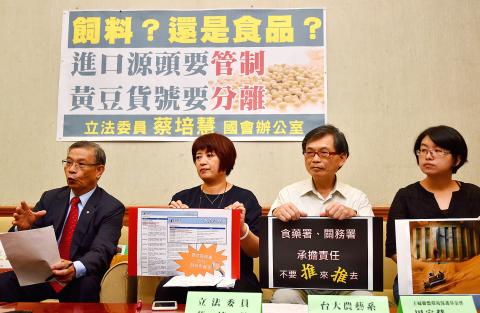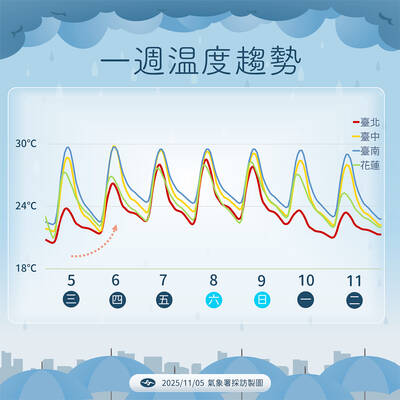While nearly 80 percent of soybeans used for food are genetically modified, the Customs Administration should strictly classify imported soybeans into different grades for different uses, Democratic Progressive Party Legislator Frida Tsai (蔡培慧) said yesterday.
A total of 2.685 million tonnes of soybeans were imported last year, but only 59,000 tonnes were non-genetically modified soybeans, she said, adding that soybeans are a common food ingredient.
According to a US agricultural report, Taiwanese consume approximately 280,000 tonnes of soybeans as food per year, which is much higher than the amount of non-genetically modified imported soybeans.

Photo: Chien Jung-fong, Taipei Times
“Soybeans should be classified and controlled when they are being imported,” Tsai said, adding that the Customs Administration should differentiate between “food-grade” and “feed-grade” soybeans, as well as “genetically modified” and “non-genetically modified” soybeans, to ensure food safety.
She suggested the agency use specialized commodity codes for the different types of soybeans.
Tsai also urged the Food and Drug Administration (FDA) to regulate that soybeans for food use must be non-genetically modified food-grade soybeans.
Genetically modified food-grade soybeans should only be used for making cooking oil, while feed-grade soybeans should not be made into any type of food, Tsai said.
A report made by Homemakers United Foundation earlier this year cited a Japanese study by the US Soybean Export Council, in which it said Japan imports about 3 million tonnes of soybeans per year, with 66 percent used for making cooking oil, 4 percent for animal feed and 30 percent for food use — such as making tofu, miso, natto and soy sauce.
Most of the direct food-use soybeans were non-genetically modified, it said.
Customs Administration Deputy Director-General Hsieh Ling-yuan (謝鈴媛) said imported soybeans are classified into non-genetically modified and genetically modified soybeans, and that differentiating between food-grade and feed-grade soybeans is technically possible, but it would require extra funding because custom officers are not able to tell them apart by sight.
FDA official Chen Hsin-cheng (陳信誠) said that it is possible to use different codes for the different types of imported soybeans and the agency would discuss the issue with the Council of Agriculture.

Three Taiwanese airlines have prohibited passengers from packing Bluetooth earbuds and their charger cases in checked luggage. EVA Air and Uni Air said that Bluetooth earbuds and charger cases are categorized as portable electronic devices, which should be switched off if they are placed in checked luggage based on international aviation safety regulations. They must not be in standby or sleep mode. However, as charging would continue when earbuds are placed in the charger cases, which would contravene international aviation regulations, their cases must be carried as hand luggage, they said. Tigerair Taiwan said that earbud charger cases are equipped

Foreign travelers entering Taiwan on a short layover via Taiwan Taoyuan International Airport are receiving NT$600 gift vouchers from yesterday, the Tourism Administration said, adding that it hopes the incentive would boost tourism consumption at the airport. The program, which allows travelers holding non-Taiwan passports who enter the country during a layover of up to 24 hours to claim a voucher, aims to promote attractions at the airport, the agency said in a statement on Friday. To participate, travelers must sign up on the campaign Web site, the agency said. They can then present their passport and boarding pass for their connecting international

UNILATERAL MOVES: Officials have raised concerns that Beijing could try to exert economic control over Kinmen in a key development plan next year The Civil Aviation Administration (CAA) yesterday said that China has so far failed to provide any information about a new airport expected to open next year that is less than 10km from a Taiwanese airport, raising flight safety concerns. Xiamen Xiangan International Airport is only about 3km at its closest point from the islands in Kinmen County — the scene of on-off fighting during the Cold War — and construction work can be seen and heard clearly from the Taiwan side. In a written statement sent to Reuters, the CAA said that airports close to each other need detailed advanced

UNKNOWN TRAJECTORY: The storm could move in four possible directions, with the fourth option considered the most threatening to Taiwan, meteorologist Lin De-en said A soon-to-be-formed tropical storm east of the Philippines could begin affecting Taiwan on Wednesday next week, the Central Weather Administration (CWA) said yesterday. The storm, to be named Fung-wong (鳳凰), is forecast to approach Taiwan on Tuesday next week and could begin affecting the weather in Taiwan on Wednesday, CWA forecaster Huang En-hung (黃恩鴻) said, adding that its impact might be amplified by the combined effect with the northeast monsoon. As of 2pm yesterday, the system’s center was 2,800km southeast of Oluanbi (鵝鑾鼻). It was moving northwest at 18kph. Meteorologist Lin De-en (林得恩) on Facebook yesterday wrote that the would-be storm is surrounded by